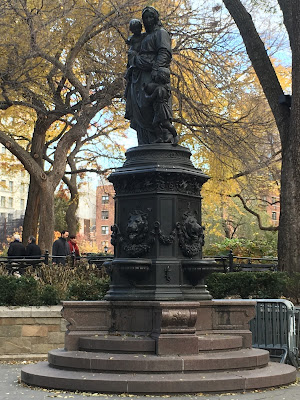As a native New Yorker, I often find myself overlooking many historically rich religious artifacts in my city. One religious object I found most intriguing was a statue of Saint Padre Pio, located in my hometown of Staten Island, one of the five boroughs of New York City. The statue, located on the outskirts of grounds occupied by St. Joseph-St.Thomas Catholic School, serves as a reminder for individuals to cherish humanity and community above all things.
The statue, protected in a concrete grotto, has stood for over a decade. It was erected to commemorate Padre Pio’s canonization in 2002. Throughout high school, I encountered it everyday on my walk home. In the past, I have seen mothers with their children pray by the statue and elderly women place rosary beads on its hands. Several years after its introduction, the administration of the catholic school and nearby parish noticed the attention and popularity of this statue. Benches were installed nearby and a garden of beautiful flowers was planted directly around the statue. Often, individuals perform the sign of the cross as they drive by it. Individuals, presumably children, leave small tokens or gifts at that statue’s feet. In the years since its introduction to my neighborhood, this statue has gained a lot of religious attention and praise. It has become a center of worship and religiosity in my community in its own right and I believe patronage and worship of this statue can be attributed to Padre Pio’s virtues of charity and voluntary poverty. These ideas are reflected through the memory and worship of Padre Pio. His statue’s presence reminds the community to prioritize such virtues.
Padre Pio lived a life of voluntary poverty as a friar, priest, and mystic. Born to a peasant family, he never experienced an abundance of wealth. Padre Pio worked in several monasteries throughout his life, collecting large sums of money for the impoverished. He ensured that these funds were distributed to the hungry, the sick, and the suffering. In his small living chambers, he refused to keep any material items, including religious items. He took his vow of poverty extremely seriously and lived the majority of his life detached from money and materialism. Dorothy Day, through her pursuit of social justice, also lived a life of voluntary poverty and servitude to the poor. Many individuals within the Catholic establishment and Catholic community at large lobby for Day’s canonization as well, due to her similar efforts in healing communities of suffering and poverty. Padre Pio’s canonization and widespread recognition for his humanitarian efforts strengthen the case for Day’s prospective canonization in the future.
Interestingly enough, this statue of Padre Pio is located around the corner from the final resting place of Dorothy Day, The Cemetery of the Resurrection. Day’s renowned history in the borough of Staten Island and the site of her burial reminds the community of the catholic worker movement and the ideas that propelled her efforts. The presence of Dorothy Day’s gravesite and this monument to Padre Pio remind the community to pay attention to those unable to climb the rungless ladder and to those trapped within the endless cycle of poverty. By evoking such connections between Day’s and Padre Pio’s work, we are reminded to resist the urge to indulge in material things and encouraged to live selflessly by giving to those less fortunate than us. I think the community of people in my neighborhood truly gravitate towards such messages of kindness and charity. I believe that the causes and pursuit of social justice championed by people like Dorothy Day and Padre Pio contribute to the religiosity of such statues and monuments. The memory and ideas of such individuals, literally and figuratively cemented in religious artifacts, are reasons why individuals genuflect at the sight of this Padre Pio statue, or leave tokens of remembrance after visits, prayers, and consolation.
Along with the apparent communal significance of this statue, I find it prudent to detail the personal significance this statue holds as well. My grandmother, a devout catholic, prayed to Padre Pio as one of her favorite saints. Prior to her death, I received a miniature statue of Padre Pio from her as a gift. Currently, it stands on a shelf in my bedroom. Whenever I see the small statue in my room or the larger statue outside the catholic school, I’m reminded of her kindred, nurturing, and generous spirit.







